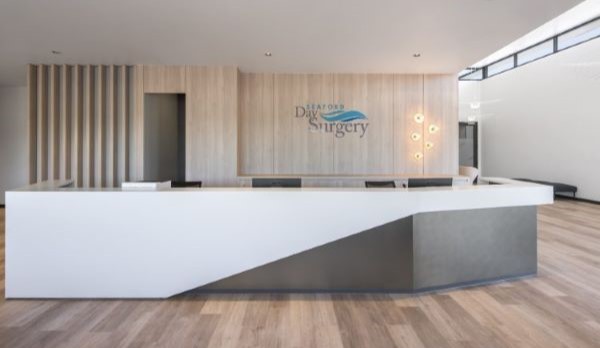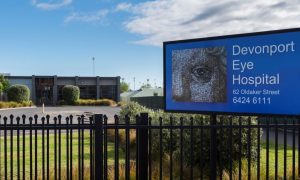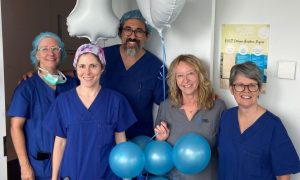Welcome to Seaford Day Surgery
Seaford Day Surgery was established in 2018 and was designed to ensure patients have access to the latest equipment and highly trained staff. Our dedicated team are committed to providing patients with personalised, safe and high-quality healthcare. We believe every person has the right to be informed and involved in every stage of their healthcare. Seaford Day Surgery has two purpose-built theatres with first and second stage recovery areas. Seaford Day Surgery joined the Cura Day Hospitals Group in 2025.

- Patient Information
- Find a Doctor
- Patient Feedback
- Australian Charter of Healthcare Rights
- Patient Safety and Quality
- Governance
- Online admissions
- Our Procedures
An anal fissure is a small tear or ulcer in the skin around the opening of the anus. Anal fissures can be treated with several different types of surgery, the most common of which are lateral internal sphincterotomy (a small incision is made in the internal anal sphincter muscle to relax it) or a fissurectomy (in which the surgeon removes all damaged skin around the fissure to enable the wound to heal).
APC is a procedure in which a Gastroenterologist seals irregular or bleeding tissue during a gastroscopy or colonoscopy using ionized argon gas.
A Colonoscopy is an examination of the colon (large intestine) using a long, thin, flexible tube with a camera called a colonoscope.
Flexible sigmoidoscopy is a test that uses a flexible, narrow tube with a light and tiny camera on one end, called a sigmoidoscope , to look inside the rectum and the lower, or sigmoid, colon.
A gastroscopy is an examination of the upper digestive tract (the oesophagus, the stomach and duodenum) using a long, thin, flexible tube with a camera called a gastroscope.
Haemorrhoid banding, or rubber band ligation (RBL) is a relatively non-invasive procedure where elastic bands are applied to the base of the haemorrhoids in order to cut off blood supply and flatten the haemorrhoids.
A haemorrhoidectomy is the surgical removal of haemorrhoids under anaesthetic.
This procedure refers to the infusion of an iron and saline mixture directly into the bloodstream through the use of an IV.
The National Bowel Cancer Screening Program (NBCSP) invites Australians aged over 50 to screen for bowel cancer using a free, simple test at home. Australia has one of the highest rates of bowel cancer in the world. Around one in 23 Australians will develop bowel cancer during their lifetime.
Click here for more information
There is no one recommended screening test for gastric cancer. Screening and diagnostic tests for oesophageal and gastric cancer can be performed via endoscopy. Other screening methods include barium swallow/upper GI x-ray or endoscopic ultrasound.
Oesophageal Dilation is a procedure performed to stretch or widen the oesophagus using weighted dilators.
Polyps are growths on the inside of the colon or gastrointestinal tract and are very common. A polypectomy can be performed during a colonoscopy or gastroscopy procedure.
Sclerotherapy is used as a treatment for Varicose and Spider Veins. It involves the injection of a solution into the vein to intentionally damage the vein causing it to gradually disappear.
Carpal tunnel release is a surgery used to treat carpal tunnel syndrome. There are two types of Carpal Tunnel Release Surgery; Endoscopic and Open.
Endoscopic carpal tunnel release surgery is the use of an endoscope to cut the transverse carpal ligament. The endoscope is usually inserted through a small incision in the palm.
During the open surgery, the surgeon will cut the carpal ligament to relieve pressure on the median nerve, and make more space for the nerve and tendons.
Open hernia repair is the procedure performed to repair hernia by pushing the hernia back in place through an abdominal incision.
A sphincterotomy is the most common treatment for anal fissure and involves surgery on the internal anal sphincter muscles.
Surgical removal of lesions is a simple procedure undertaken to remove growths such as lesions, tumours or moles for either medical or cosmetic reasons.
Wedge resection toenail is the surgical treatment for an ingrown toenail.
A blepharoplasty is a procedure which removes excess or sagging skin from upper and/or lower eyelids. The surgery is usually performed for cosmetic reasons however; it can improve sight in patients whose eyelids are obscuring their vision.
A chalazion is a lump on the eyelid that is usually caused by obstruction of the drainage duct of an oil gland within the upper or lower eyelid. Surgical removal of chalazion may become necessary if vision becomes obscured, or an astigmatism.
Ectropion is a medical condition where the eyelid folds outward. Corrective surgery involves the removal of a small piece of the fold to tighten the muscles in the area.
Entropion is a medical condition where the eyelid folds inward. Corrective surgery involves the removal of a small piece of the fold to tighten the muscles in the area.
Excision of lesions is a procedure to remove growths such as lesions, moles and tumours from the skin, sometimes accompanied by frozen sections and followed by sutures or a graft. The most common reason for undertaking this procedure is for the removal of skin cancers such as Basal Cell Carcinoma which is the most common skin cancer on the face.
Ptosis is a drooping of the upper eyelid. Corrective surgery is performed by tightening the levator muscle through an incision in the normal crease in the upper lid.
A wedge excision is a procedure which removes cancers from the edge of the eyelid.
Cataract surgery is the surgical replacement of a cloudy lens with an artificial intraocular lens (IOL) implant to restore vision. The cloudy lens is broken up and removed with an ultrasound probe through a very small incision in the eye, and the artificial lens is inserted.
Intravitreal injections are used in the treatment of Age-Related Macular Degeneration. The Injections work by inhibiting the growth of abnormal blood vessels at the macula, and help to prevent leakage of these blood vessels.
A pterygium is a growth of blood vessels and fibrous tissues covering the surface of the eye due to over-exposure to sunlight over an extended period of time. A pterygium is treated with a surgical excision and an auto-conjunctival graft.
A temporal artery biopsy is the most common diagnostic test for giant cell arteritis.
Glaucoma is characterised by elevated intraocular pressure associated with optic cupping and visual field loss. Trabeculectomy surgery lowers intraocular pressure by forming a new drainage to allow fluid to escape from the eye.
When wisdom teeth have the potential to cause problems or become impacted, they may be removed surgically. In the procedure, the surgeon makes a small incision and extracts the tooth with forceps.
A tooth extraction is the removal of a tooth from the dental alveolus (socket) in the alveolar bone.
Carpal tunnel release is a surgery used to treat carpal tunnel syndrome. During the surgery, the surgeon will cut the carpal ligament to relieve pressure on the median nerve, and make more space for the nerve and tendons.
Dupuytren’s contracture is the development of a fibrous connection between the finger tendons and the skin of the palm resulting in a forward curvature or ‘clawing’ of one or more fingers. Treatment for Dupuytren’s contracture includes needling, injections and surgical procedures to sever the tissue causing the contracture.
Trigger Finger, also known as stenosing tenosynovitis or flexor tendonitis, is a condition where one of the fingers or thumb of the hand is caught in a bent position. Surgery may be undertaken to release the tight portion of the flexor tendon sheath.
The circumcision procedure (for infant males) involves the use of a Plastibell (a small plastic ring) which is slipped over the glans, and the foreskin is laid over it.
A cystoscopy is a procedure in which a thin flexible tube with a camera and light on the end is inserted through the urethra and into the bladder. The procedure is most commonly undertaken to investigate the bladder for any abnormalities.
A frenuloplasty is a procedure used to treat pain caused by tight or short frenulum of the penis.
A stent removal is the removal of a ureteral stent by a surgeon using a cystoscope. A cystoscope is a thin, flexible tube with a camera and a light that is inserted through the urethra.
Urodynamics involves bladder and urethra assessments
A vasectomy is a surgical procedure that sterilises a man by cutting the vas deferens, which are tubes that carry sperm from the testes to the penis.
As with endovenous laser ablation (EVLA), radiofrequency ablation (RFA) relies on thermal (heat based) damage to the vein, that leads to immediate closure of the vein. Once the vein is treated by radiofrequency ablation, it will gradually undergo complete absorption by the body and disappear over time.
Contact Details
Opening Hours: 7:00am to 5:00pm, Monday to Friday. Our friendly personnel are always ready to assist with your enquiries.
Tel: (08) 7282 8011
Contact Person: Gail Mogg, Director of Nursing [email protected]
Address: 4 Vista Parade, Seaford Heights, SA 5169
- Follow Seaford Day Surgery on social



